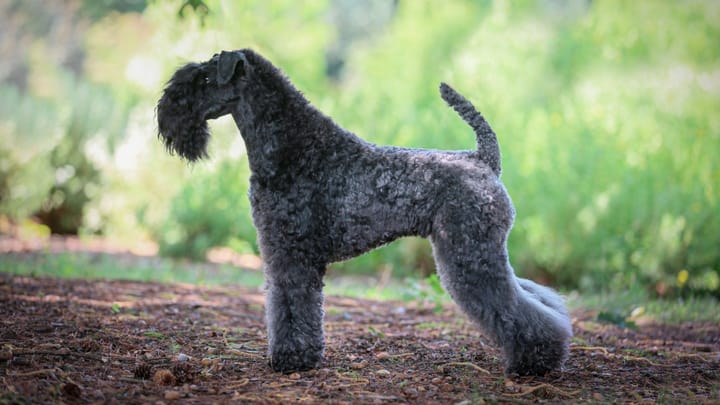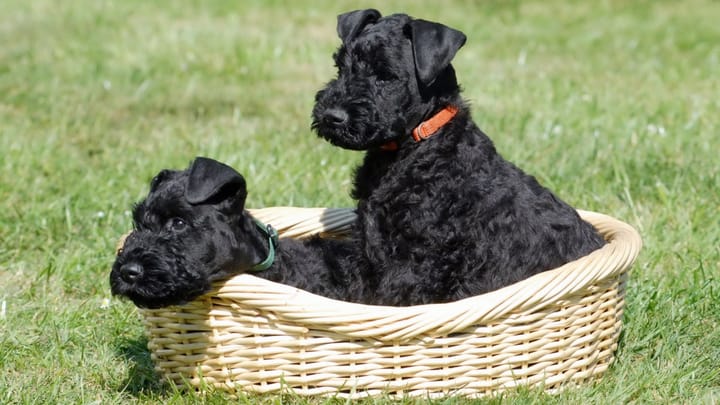Kerry Blue Terrier
Other names : Kerry, Kerries, Irish Blue Terrier


The Kerry Blue Terrier originates from Ireland - can you guess where? Yep, it’s the County Kerry region! They were originally bred as working dogs, to hunt small animals in fields, streams and lakes and herd livestock.
You’ve probably noticed the Kerry Blue’s dashing good looks already - they’re certainly unique! This breed is a familiar face in the dog show circuit thanks to these natural, charming looks.
And what about the Kerry Blue Terrier as a pet? Well, they’re a typical terrier, that’s for sure! They’re alert, lively, bold, independent and sometimes a little feisty. However, when it comes to their family, they can be extremely affectionate, loyal and loving - they’ve got a definite soft side!
|
Life expectancy |
The Kerry Blue Terrier has a life expectancy of between 13 and 15 years |
|
Temperament |
|
|
Size |
Medium
|
|
Adult size |
Female
Between 17 and 19 in
Male
Between 18 and 19 in
|
|
Adult weight |
Female
Between 31 and 37 lb
Male
Between 55 and 40 lb
|
|
Coat colour
The Kerry’s coat is normally a shade of blue, but is also seen in black and blue or pure black. Puppies are often born blue and darken as the years go by. They often have small patches of white hair, too. |
Blue |
|
Type of coat
This breed boasts a short-medium length coat. The Kerry Blue Terrier has a wonderful coat! It’s a single, soft, silky, dense and fairly wavy coat which is also considered hypoallergenic. |
Wavy Long |
|
Eye colour
The eyes of a Kerry Blue Terrier are dark - a deep brown to black. |
Brown
|
|
Purchase price |
The Kerry Blue Terrier costs between £640 and £830 |
This breed owes its name to County Kerry, where it seems that the blue color was selected for all domestic animals: dogs, cows, pigs and even chickens.
More details about the Kerry Blue Terrier
Kerry Blue Terrier: Origins and history
This breed was officially recognised only in 1920, but some dogs had already been exhibited in 1887 in Ireland. It most likely comes from the color-based selection of the Irish Terrier soft-haired: this thesis is mostly confirmed by the texture of the dress (soft and silky) that is common to both breeds.
Physical characteristics of the Kerry Blue Terrier
The Kerry Blue Terrier is a unique looking dog - in fact, they’re well known for their good looks! This is a medium-sized, sturdy breed with a plush, silky coat. They have long, elegant necks, high-set tails and muscular legs which show bone.
They have small, focused and extremely dark eyes, lovely V-shaped ears and a black nose. One of the best parts of the Kerry has got to be their beard - it’ll put yours to shame!
FCI classification of the Kerry Blue Terrier
-
Group 3 - Terriers
-
Section 1 : Large and medium sized Terriers
Kerry Blue Terrier: Characteristics
Kerry Blue Terrier: Behaviour
Training a Kerry Blue Terrier
Training and early socialisation is critical for the Kerry Blue Terrier. Without it, they can be a nightmare - with it, they can be a wonderful dog. However, this breed is pretty stubborn, meaning training can be difficult.
Start when the Kerry is a puppy with plenty of short, fun training sessions and socialisation classes and carry this on consistently moving forward. The Kerry hates negativity and will react best to positive reinforcement and reward-based training.
Kerry Blue Terrier: Lifestyle
Breed compatibility Kerry Blue Terrier
Kerry Blue Terrier: Purchase price
You’ll need to pay betwee, £640 to £830 for a well-bred Kerry Blue Terrier.
Concerning your monthly budget to care for the Kerry, the price varies approximately between £30 to £40.
Kerry Blue Terrier: Shedding
Average
The Kerry Blue Terrier's hairloss is moderate.
Kerry Blue Terrier: Grooming
The Kerry Blue Terrier is rather high-maintenance in terms of grooming. Although their sleek coat is undeniably beautiful, it does seem to attract dirt, mud, dust and twigs like there’s no tomorrow. Therefore, it will need a thorough daily brushing and monthly bathing.
The Kerry also has a beard which needs trimming - though beard style is completely down to the owner’s preference. Be aware, though, that it can get messy at meal times - have a cloth at the ready!
Brush their teeth at least 2-3 times per week, though every day is always best. Active Kerrys will wear their nails down naturally, but it’s still a good idea to check and trim them if necessary. As always, make sure to check ears and eyes for dirt and signs of infection.
Kerry Blue Terrier: Health
The Kerry will live, on average, between 13 and 15 years.
Although they’re only a medium-sized breed, the Kerry is pretty sturdy and powerful - they’re tough cookies!
The Kerry doesn’t cope well in hot weather and will act lethargic and weak. If temperatures rise, make sure they have access to a cold, dark room and ice cold water.
This dog is popular in colder countries and can tolerate low temperatures pretty well. However, they shouldn't be left outside in extreme temperatures as their coat isn’t completely weatherproof.
This breed is rarely concerned with overweight.
- Itchy allergies
- Hair loss
- Cataracts
- Entropion
- Keratoconjunctivitis Sicca
- Hip & elbow dysplasia
- Retinal folds
- Thyroid disease
- Cerebellar abiotrophy
- Blood-clotting disease






